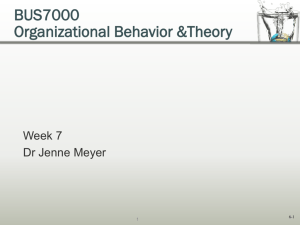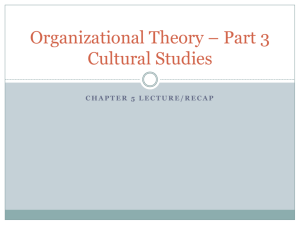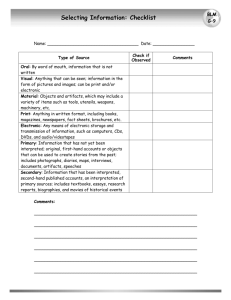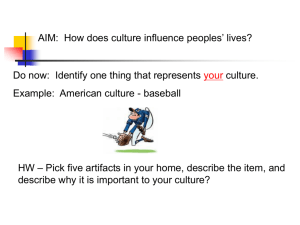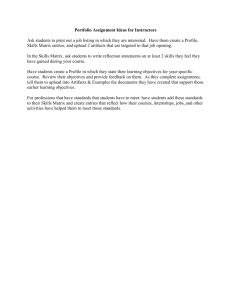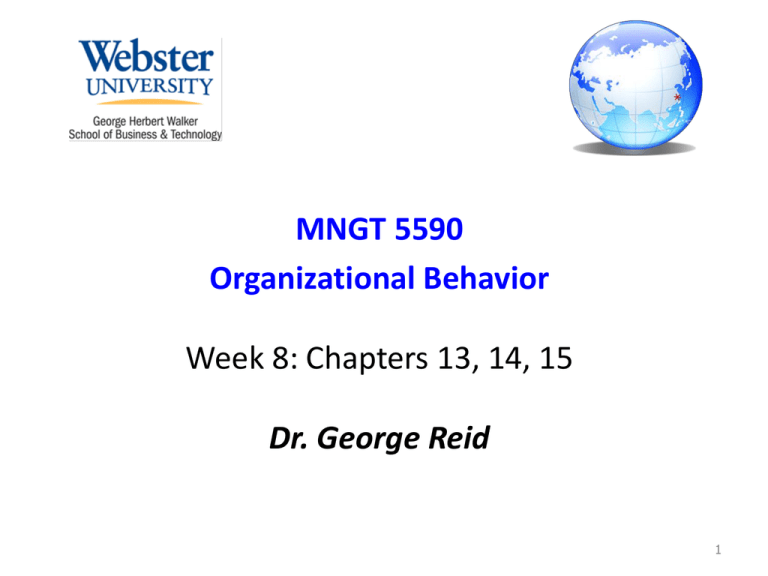
MNGT 5590
Organizational Behavior
Week 8: Chapters 13, 14, 15
Dr. George Reid
1
• Chapter 13: Designing
Organizational Structures
• Chapter 14: Organizational
Culture
• Chapter 15: Leadership
2-2
13
Designing
Organizational
Structures
Copyright © 2015 McGraw-Hill Education. All rights reserved. No reproduction or distribution without the prior written consent of McGraw-Hill Education.
Valve Corporation’s
Organizational Structure
Valve Corporation has a flat, organic organizational
structure to leverage the creative and entrepreneurial
potential of its 300 employees
13-4
Organizational Structure
Defined
Division of labor and patterns of coordination,
communication, workflow, and formal power that
direct organizational activities
Relates to many OB topics (job design, teams,
power)
13-5
Division of Labor and
Coordination
Division of labor
Results in specialization, separate jobs for different people
Improves work efficiency
Coordination of work
Value of division of labor is limited to ability to coordinate
that work
Coordinating work can be costly
Three coordinating mechanisms
informal communication
formal hierarchy
standardization
13-6
Coordination Through Informal
Communication
Informal communication coordinates work in
all firms
Vital in nonroutine and ambiguous situations
Easiest in small firms, but technology extends
its use in large firms
Larger firms also apply informal
communication through
Liaison roles
Integrator roles
Temporary teams
13-7
Other Coordinating
Mechanisms
Formal hierarchy
Direct supervision
Assigns legitimate power to manage others
Necessary in most firms, but has problems
Standardization – create routine
behavior/output
Standardized processes (e.g., job descriptions)
Standardized outputs (e.g., sales targets)
Standardized skills (e.g., training)
13-8
Elements of Organizational
Structure
Departmentalization
Span of
Control
Elements of
Organizational
Structure
Formalization
Centralization
13-9
KenGen’s Flatter Structure
KenGen, Kenya’s leading electricity
generation company, reduced its
hierarchy from 15 layers to just 6
layers. “This flatter structure has
reduced bureaucracy and it has also
improved teamwork,” explains
KenGen executive Simon Ngure.
13-10
Span of Control
Number of people directly reporting
to the next level
Wider span of control possible when:
Other coordinating mechanisms are
present
Routine tasks
Low employee interdependence
13-11
Tall vs Flat Structures
As companies grow, they:
Build a taller hierarchy
Widen span, or both
Problems with tall hierarchies
Poorer upward information
Overhead costs
Focus power around managers, so staff
feel less empowered
13-12
Centralization/Decentralization
Centralization – Formal
decision making authority
is held by a few people,
usually at the top
Decentralization increases
as companies grow
Varying degrees of
centralization in different
areas of the company
Example: sales
decentralized; info systems
centralized
Production
Information
Systems
Sales
Upper Mgt
Upper Mgt
Upper Mgt
Middle Mgt
Middle Mgt
Middle Mgt
Supervisory
Supervisory
Supervisory
Front line
Front line
Front line
= locus of decision making authority
13-13
Formalization
Standardizing behavior through rules,
procedures, training, etc
Increases as firms get older, larger, regulated
Problems with formalization
Less organizational flexibility
Discourages organizational learning/creativity
Less work efficiency
Increases job dissatisfaction and work stress
Rules/procedures become focus of attention
13-14
Mechanistic vs. Organic
Structures
Mechanistic Structure
Narrow span of control
High centralization
High formalization
Organic Structure
Wide span of control
Decentralized decisions
Low formalization
13-15
Functional Organizational
Structure
Organizes employees around specific knowledge or
other resources (e.g., marketing, production)
CEO
Finance
Production
Marketing
13-16
Evaluating Functional Structures
Benefits
Economies of scale
Supports professional identity and career paths
Easier supervision
Limitations
Emphasizes subunit more than organizational goals
Higher dysfunctional conflict
Poorer coordination – requires more controls
13-17
Divisional Structure
Organizes employees around outputs,
clients, or geographic areas
CEO
Healthcare
Lighting
Products
Consumer
Lifestyle
13-18
Divisional Structure
Best type of divisional structure depends on
environmental diversity or uncertainty
Geographic structures becoming less
common because:
Less need for local representation
Reduced geographic variation
More global clients
13-19
Evaluating Divisional Structures
Benefits
Building block structure – accommodates growth
Focuses on markets/products/clients
Limitations
Duplication, inefficient use of resources
Silos of knowledge – expertise isolated across
divisions
Executive power affected by shifting divisional
structure – common with complex environment
13-20
Team-Based Structure
Self-directed work teams organized around work
processes
Typically organic structure
Usually found within divisionalized structure
13-21
Evaluating Team-Based
Structures
Benefits
Responsive, flexible
Lower admin costs
Quicker, more informed decisions
Limitations
Interpersonal training costs
Slower coordination during team development
Role ambiguity increases stress
Team leader issues – less power, ambiguous
roles/career
Duplication of resources
13-22
ABB’s* Geographic-Product
Matrix Structure
Regional Groups
Product Groups
North
America
South
America
Europe
Middle East,
Africa/ India
Asia
Pacific
Power Products
Power Systems
Discrete Automation
and Motion
Low Voltage
Products
Process
Automation
*Simplification of ABB’s actual structure
Product leader in that region
13-23
Project-based Matrix Structure
Employees ( ) are temporarily assigned to a specific
project team and have a permanent functional unit
CEO
Game1
Project Leader
Game2
Project Leader
Game3
Project Leader
Art Dept
Leader
Software
Dept Leader
Audio Dept
Leader
13-24
Evaluating Matrix Structures
Benefits
Uses resources and expertise effectively
Potentially better communication, flexibility, innovation
Focuses specialists on clients and products
Supports knowledge sharing within specialty
Solution when two divisions have equal importance
Limitations
More conflict among managers who share power
Two bosses dilutes accountability
More conflict, organizational politics, and stress
13-25
External Environment & Structure
Dynamic
• High rate of change
• Use team-based, network, or
other organic structure
Complex
• Many elements (such as
stakeholders)
• Decentralize
Stable
• Steady conditions,
predictable change
• Use mechanistic structure
Simple
• Few environmental elements
• Less need to decentralize
13-26
Effects of Organizational Size
As organizations grow, they:
1. Increase division of labor (job
specialization)
2. Increase standardization
and formal hierarchy as
coordinating mechanisms
3. Become more decentralized
13-27
Organizational Strategy
Structure follows strategy
Strategy points to the environments in
which the organization will operate
Leaders decide which structure to apply
Innovation strategy
Providing unique products or attracting
clients who want customization
Cost leadership strategy
Maximize productivity in order to offer
competitive pricing
13-28
13
Designing
Organizational
Structures
13-29
14
Organizational
Culture
Copyright © 2015 McGraw-Hill Education. All rights reserved. No reproduction or distribution without the prior written consent of McGraw-Hill Education.
Zappos’ Organizational Culture
Zappos, the world’s largest online shoe retailer,
relies on recruitment, selection, socialization,
and other practices to maintain a strong
organizational culture
14-31
Organizational Culture Defined
The values/assumptions shared within an
organization
Defines what is important
Provides direction toward the “right way” of
doing things
Company’s DNA – invisible to the eye, yet a
powerful template that shapes employee
behavior
14-32
Artifacts of
organizational
culture
Elements of
Organizational
Culture
Organizational
culture
14-33
Content of
Organizational Culture
The relative ordering of values.
A few dominant values
Example: Facebook – creative, proactive, risk-oriented
Problems with measuring org culture
Oversimplifies diversity of possible values
Ignore shared assumptions
Adopts an “integration” perspective
An organization’s culture is fuzzy:
Diverse subcultures (“fragmentation”)
Values exist within individuals, not work units
14-34
Organizational Culture Profile
Org Culture
Dimensions
Dimension Characteristics
Innovation
Experimenting, opportunity seeking, risk taking, few
rules, low cautiousness
Stability
Predictability, security, rule-oriented
Respect for people
Fairness, tolerance
Outcome orientation
Action oriented, high expectations, results oriented
Attention to detail
Precise, analytic
Team orientation
Collaboration, people-oriented
Aggressiveness
Competitive, low emphasis on social responsibility
Source: O’Reilly et al (1991)
14-35
Organizational Subcultures
Dominant culture – most widely shared
values and assumptions
Subcultures
Located throughout the organization
Can enhance or oppose (countercultures) firm’s
dominant culture
Two functions of countercultures:
provide surveillance and critique, ethics
source of emerging values
14-36
Cultural Artifacts at
Goldman Sachs
The language of Goldman Sachs employees may
be artifacts of underlying cultural values. “Elephant
trades” and “muppet” clients suggest that the
investment firm values profitability and individual
performance more than customer service.
14-37
Organizational Culture Artifacts
Observable symbols and signs of culture
Physical structures, ceremonies, language, stories
Maintain and transmit organization’s culture
Need many artifacts to accurately decipher a
company’s culture
14-38
Artifacts: Stories and Legends
Social prescriptions of desired (or
dysfunctional) behavior
Realistic human side to expectations
Most effective stories and legends:
Describe real people
Assumed to be true
Known throughout the organization
Are prescriptive
14-39
Artifacts: Rituals, Ceremonies,
Language
Rituals
programmed routines
(e.g., how visitors are greeted)
Ceremonies
Planned activities for an audience
e.g., award ceremonies
Language
How employees address each other and outsiders,
express emotions, describe stakeholders, etc.
Leaders use language to anchor or change culture
Language also differentiates subcultures
14-40
Artifacts: Physical
Structures/Symbols
Building structure – may shape and reflect culture
Office design conveys cultural meaning
Furniture, office size, wall hangings, art deco
14-41
Organizational Culture Strength
How widely and deeply employees hold the
company’s dominant values and
assumptions
Most employees understand/embrace the culture
Institutionalized through artifacts
Long-lasting – possibly back to founder(s)
Three functions of strong cultures :
Control system
Social glue
Sense-making
14-42
Organizational Culture
and Effectiveness
Culture strength
advantages depend on:
• Environment fit
• Moderate strength
• Adaptive culture
Functions of
Strong Cultures
• Control system
• Social glue
• Sense-making
Organizational
Outcomes
• Org performance
• Employee well-being
14-43
Merging Cultures:
Bicultural Audit
Part of due diligence in merger
Minimizes cultural collision by diagnosing
companies
Three steps in bicultural audit:
1. Identify cultural artifacts
2. Analyze data for cultural conflict/compatibility
3. Identify strategies and action plans to bridge
cultures
14-44
Merging Organizational
Cultures
Assimilation
Deculturation
Acquired company embraces acquiring
firm’s cultural values
Acquiring firm imposes its culture on
unwilling acquired firm
Integration
Cultures combined into a new composite
culture
Separation
Merging companies remain separate with
their own culture
14-45
Changing/Strengthening
Organizational Culture
14-46
Changing/Strengthening
Organizational Culture
1. Actions of founders/leaders
Founder’s values/personality
Transformational leaders can reshape culture –
organizational change practices
2. Aligning artifacts
Artifacts keep culture in place
14-47
Changing/Strengthening
Organizational Culture
3. Introducing culturally consistent rewards
Rewards are powerful artifacts
4. Support workforce stability and
communication
High turnover weakens org culture
Strong culture depends on frequent,
open communication
5. Attracting, selecting, and
socialization of employees
Attraction-selection-attrition theory
Socialization practices
14-48
Attraction-Selection-Attrition
Theory
Organizations become more homogeneous
(stronger culture) through:
Attraction – applicants self-select and weed out
companies based on compatible values
Selection – applicants selected based on values
congruent with organization’s culture
Attrition – employees quit or are forced out when
their values oppose company values
14-49
Organizational Socialization
The process by which individuals learn the values,
expected behaviors, and social knowledge
necessary to assume their roles in the organization
Learning Process
Newcomers make sense of the organization’s physical,
social, and strategic/cultural dynamics
Adjustment Process
Newcomers adapt to new work roles, team norms, etc.
14-50
Stages of Socialization
Pre-Employment
Stage
Encounter
Stage
Role
Management
• Outsider
• Newcomer
• Insider
• Gathering
information
• Testing
expectations
• Changing roles
and behavior
• Forming
psychological
contract
• Resolving
conflicts
14-51
Improving Organizational
Socialization
Realistic job preview (RJP)
A balance of positive and negative information
about the job and work context
Socialization agents
Supervisors – technical information, performance
feedback, job duties
Co-workers – ideal when accessible, role models,
tolerant, and supportive
14-52
14
Organizational
Culture
14-53
15
Organizational
Change
Copyright © 2015 McGraw-Hill Education. All rights reserved. No reproduction or distribution without the prior written consent of McGraw-Hill Education.
Organizational Change
at LG Group
LG Group chairman Koo Bon-moo (shown) is creating
an urgency to change Korea’s second largest
conglomerate into a more proactive, marketplace
leader rather than a follower of Samsung
15-55
Force Field Analysis Model
Driving forces
Push organizations toward change
External forces or leader’s vision
Restraining
Forces
Restraining forces
Resistance to change – employee
behaviors that block the change process
Driving
Forces
15-56
Force Field Analysis Model
Restraining
Forces
Desired
Conditions
Restraining
Forces
Restraining
Forces
Current
Conditions
Driving
Forces
Before
Change
Driving
Forces
Driving
Forces
During
Change
After
Change
15-57
Restraining Forces
(Resistance to Change)
Many forms of resistance
complaints, absenteeism, passive noncompliance
View resistance as a resource
1. Symptoms of deeper problems in the change process
2. A form of task conflict – may improve change decisions
3. Form of voice – procedural justice
15-58
Why People Resist Change
1.Negative valence of change
Negative cost-benefit analysis
2.Fear of the unknown
People assume worst when future unknown
Perceive lack of control
3. Not-invented-here-syndrome
Staff oppose the change to prove their ideas were
better
successful change threatens self-esteem
15-59
Why People Resist Change
4. Breaking routines
Cost of moving away from our “comfort zones”
Time/effort to learn new routines
5. Incongruent team dynamics
Norms contrary to desired change
6.Incongruent organizational systems
Systems/structures reinforce status quo
rewards, information systems, patterns of authority,
career paths, selection criteria
15-60
Creating an Urgency for
Change
Inform employees about driving forces
Most difficult when organization is doing well
Customer-driven change
Human element energizes employees
Reveals problems and consequences of inaction
Sometimes need to create urgency to
change without external drivers
Requires persuasive influence
Use positive vision rather than threats
15-61
Reducing the Restraining Forces
1. Communication
Highest priority and first strategy for change
Generates urgency to change
Reduces uncertainty (fear of unknown)
Problems: time consuming and costly
2. Learning
Provides new knowledge/skills
Includes coaching and other forms of learning
Helps break old routines and adopt new roles
Problems: potentially time consuming and costly
15-62
Reducing the Restraining Forces
3. Involvement
Employees participate in change process
Helps saving face and reducing fear of unknown
Includes task forces, future search events
Problems: time-consuming, potential conflict
4. Stress management
When previous strategies do not minimize stress enough
Potential benefits
More motivation to change
Less fear of unknown
Fewer direct costs
Problems: time-consuming, costly, doesn’t help all
15-63
Reducing the Restraining Forces
5. Negotiation
Influence by exchange – reduces direct costs
May be necessary when people clearly lose something and
won’t otherwise support change
Problems: expensive, gains compliance, not commitment
6. Coercion
When all else fails
Assertive influence
Radical form of “unlearning”
Problems
Reduces trust
May create more subtle resistance
Encourage politics to protect job
15-64
Alan Mulally: Change Agent
Alan Mulally’s “One Ford” vision and his
transformational leadership were key factors in the
successful turnaround of Ford Motor Company.
15-65
Change Agents
Change agent – possesses knowledge and
power to guide and facilitate the change effort
Involves transformational leadership
Strategic visions and change
Provides a sense of direction
Identifies critical success factors to valuate change
Links employee values to the change
Minimizes employee fear of the unknown
Clarifies role perceptions
15-66
Coalitions, Social Networks and
Viral Change
Guiding coalition
Representative across the firm
Influence leaders – respected
Viral change
Information seeded to a few people, then transmitted
through social networks
Social networks influence others due to:
high trust
referent power
behavior observation
15-67
Diffusion of Change
Begin change as pilot projects
Effective diffusion applies the MARS model
Motivation
Pilot project employees rewarded; motivate others to
adopt pilot project
Ability
Train employees to adopt pilot project
Role perceptions
Translate pilot project to new situations
Situational factors
Provide resources to implement pilot project elsewhere
15-68
Action Research Approach
Action orientation and research orientation
Action – to achieve the goal of change
Research – testing application of concepts
Action research principles
1. Open systems perspective
2. Highly participative process
3. Data-driven, problem-oriented process
15-69
Action Research Process
Form
clientconsultant
relations
Diagnose
need for
change
Introduce
intervention
Evaluate/
stabilize
change
Disengage
consultant’s
services
15-70
Appreciative Inquiry Approach
Frames change around positive and possible future,
not problems.
1. Positive principle
focus on positive, not problems
2. Constructionist principle
conversations shape reality
3. Simultaneity principle
inquiry and change are simultaneous
4. Poetic principle
we can choose how to perceive situations (glass half full)
5. Anticipatory principle
people are motivated by desirable visions
15-71
Four-D Model of
Appreciative Inquiry
Discovery
Dreaming
Designing
Delivering
Discovering
the best of
“what is
Forming
ideas about
“what might
be”
Engaging in
dialogue
about “what
should be”
Developing
objectives
about “what
will be”
15-72
Large Group Interventions
Future search, open space, and other
interventions that involve “the whole system”
Large group sessions
May last a few days
High involvement with minimal structure
Limitations of large group interventions
Limited opportunity to contribute
Risk that a few people will dominate
Focus on common ground may hide differences
Generates high expectations about ideal future
15-73
Parallel Learning Structure
Approach
Highly participative social structures
Members representative across the formal
hierarchy
Sufficiently free from firm’s constraints
Develop change solutions – then applied
back into the larger organization
15-74
Cross-Cultural and Ethical Concerns
with Managing Change
Cross-Cultural Concerns
Linear and open conflict assumptions different
from values in some cultures
Ethical Concerns
Privacy rights of individuals
Management power
Individuals’ self-esteem
15-75
Organizations are About People
“Take away my people, but leave my factories,
and soon grass will grow on the factory floors.
Take away my factories, but leave my people,
and soon we will have a new and better
factory.”
Andrew Carnegie (1835-1919)
15-76
15
Organizational
Change
15-77


